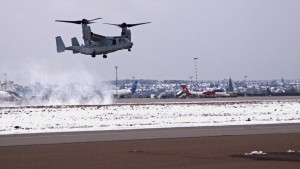2013-03-27 The range and speed of the Osprey is a key capability which enables the ARG-MEU.

It allows for a increased capability to disaggregate the ARG-MEU as well.
And it allows for support from greater distance, in this case more than 1400 miles.
The Osprey pictured in this photo is landing in Stuttgart after departing the USS Kearsarge somewhere off of Rota Spain.
And it provides a combat capability which an insertion force needs to be prepared to use in raiding parties or other concepts of operations.
In a recent exercise in South Korea, the Osprey was out-runnning the ability of the US Army to make use of the rapid transport.
It took 56 days for the United States to flow two divisions’ worth of soldiers into the failed nuclear-armed state of “North Brownland” and as many as 90,000 troops to deal with the country’s nuclear stockpiles, a major U.S. Army war game concluded this winter.
The Unified Quest war game conducted this year by Army planners posited the collapse of a nuclear-armed, xenophobic, criminal family regime that had lorded over a closed society and inconveniently lost control over its nukes as it fell. Army leaders stayed mum about the model for the game, but all indications — and maps seen during the game at the Army War College — point to North Korea.
While American forces in a neighboring friendly country to the south eventually made it over the border into North Brownland, they encountered several problems for which they struggled to find solutions. One of the first was that a large number of nuclear sites were in populated areas, so they had to try to perform humanitarian assistance while conducting operations.
One way of doing this was to “use humanitarian assistance as a form of maneuver,” Maj. Gen. Bill Hix, director of the Army’s Concept Development and Learning Directorate, said. The Army dropped humanitarian supplies a short distance from populated areas, drawing the population away from the objective sites, he explained.
To move soldiers quickly, Marine Corps V-22 Ospreys quickly inserted Army units deep behind enemy lines, but leaders found that inserting troops far in front of the main force so quickly often caused them to be surrounded, after which they had to be withdrawn.
According to a USMC article:
For the exercise, three MV-22B Ospreys flew from an aircraft carrier on the Atlantic Ocean, past Rota, Spain, to Stuttgart, Germany, two days ago without having to land; a total of 1,400 nautical miles.
“It’s very important that we demonstrate this capability that the Marine Corps brings to the commands in the assault-support realm,” said Boniface, the Enterprise, Ala., native.
The MV-22B Osprey is a multi-engine, dual-piloted, self-deployable, medium-lift, vertical-takeoff and landing, tilt-rotor aircraft designed for combat support and special-operations missions. It combines the functionality of a helicopter with the performance of a turbo-prop aircraft.
“It’s the only airplane that can do everything a helicopter can,” said Capt. Erik B. Kolle, an MV-22B pilot, VMM-266, 26th MEU, II MEF. “It has proven in the last several years that it is a good choice,” added the Raleigh, N.C., native.
The MV-22B represents new capabilities in the region and can provide Marine Forces Europe and Marine Forces Africa a unique asset supporting their mission to respond to crisis, build partner-nation military capacity, promote regional security, and maintain a stabilization presence as directed by EUCOM and AFRICOM to protect U.S. national security interests.
“It takes the Mediterranean Sea, for example, and turns it into a lake,” said Kolle, regarding the rapid travelling capability of the MV-22B.
“Before, if a MEU wanted to reach an area, they would have to bring the ships closer to that region and deploy helicopters. Now, with the MV-22B, you can have a MEU floating in Spain and have troops on the other end of the Mediterranean the same day,” said Kolle.
“If AFRICOM and EUCOM are going to have MV-22Bs in their areas of responsibility, it’s important to know how to employ these assets in the event that something happens,” added Kolle.
And Stars and Stripes added addition information:
“Africa is an enormous continent. And what we’re demonstrating is ‘Hey … you have assets now that can reach out on their own, independently, and go 1,400 miles away and influence your theater.’”
During the past couple of years, the Marine Corps has been elevating its profile within Europe, even as the overall U.S. military presence on the continent has been shrinking. In 2010, Marine Forces Europe launched its Black Sea Rotational Force, which focuses on training foreign militaries in eastern Europe. Each year, the task force, comprised mostly of reservists, spends roughly five months overseas, conducting missions with numerous allied nations.
The Black Sea effort was followed up in 2011 with a similar Africa-focused Special Purpose Marine Air Ground Task Force, based out of Sigonella, Italy. Most of that unit’s time is spent on the African continent, training foreignarmies in everything from logistics management to counter-terrorism tactics.
Meanwhile, a second Africa-focused Marine MAGTF with a special focus on crisis-response also is being developed. For such a unit, the Osprey would likely be the aircraft of choice.
“So, when you say Marines in a MAGTF, you’re talking Osprey, you’re talking riflemen, you’re talking artillery, tanks,” Coates said. “You’re talking the whole package. And that’s what people really need to take away is what we bring to the table.”
The Marine Corps’ increased attention on Africa comes as Africa Command confronts a growing threat posed by Islamic militant groups operating across much of northern Africa, from Somalia to Libya and Mali.
And for our German readers:

